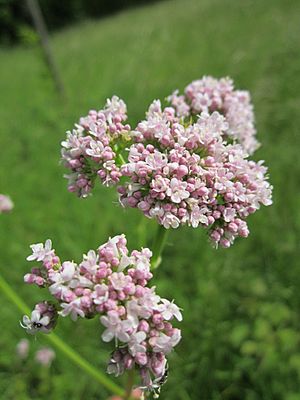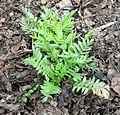Valerian (herb) facts for kids
Quick facts for kids Valerian |
|
|---|---|
 |
|
| Scientific classification | |
| Genus: |
Valeriana
|
| Species: |
officinalis
|
Valerian (Valeriana officinalis) is a perennial flowering plant. This means it lives for more than two years. It grows naturally in Europe and Asia.
In summer, a grown Valerian plant can reach about 1.5 meters (5 feet) tall. It has sweet-smelling pink or white flowers. These flowers attract many types of flies, especially hoverflies. The plant is also a food source for the young (larvae) of some Lepidoptera species, like butterflies and moths. One example is the grey pug moth.
People often use Valerian root. Extracts from the root might help you feel calm or sleepy. It is often sold in dietary supplement capsules to help people sleep better.
Contents
History of Valerian Use
Valerian has been used as a special herb for a very long time. People in ancient Greece and Rome used it. Hippocrates, a famous doctor from ancient Greece, wrote about its uses. Later, another doctor named Galen suggested it for people who couldn't sleep.
In medieval Sweden, people sometimes put Valerian in a groom's wedding clothes. They believed it would protect him from elves. In the 1500s, a reformer named Pilgram Marpeck even gave Valerian tea to a sick woman.
John Gerard wrote a book called Herball in 1597. He said that people back then thought Valerian was great for those who felt burdened or had muscle spasms. He also mentioned it was good for people hurt in falls. He wrote that poor people in northern England and southern Scotland really valued the dried root as medicine. They thought no soup or special food was good without Valerian.
In the 1600s, a botanist named Nicholas Culpeper believed Valerian was linked to the planet Mercury. He thought it had a warming effect. He suggested using both the plant and its root. He said boiling the root with liquorice, raisins, and aniseed was good for coughs. He also thought it helped against the plague if you drank a tea from it and smelled the root. He even said that crushing the green plant and putting it on your head could stop pain.
What Valerian is Called
The name "Valerian" comes from the old Roman name Valeria. It also comes from the Latin word valere, which means "to be strong" or "healthy."
This plant has many other names. People call it garden valerian to tell it apart from other similar plants. It's also known as garden heliotrope, even though it's not related to the Heliotropium plant. Other names include setwall and all-heal. Be careful, though, because "all-heal" is also used for other plants.
Sometimes, people call Red valerian just "valerian." But Red valerian is a different plant, even though it's in the same plant family. They are not very closely related.
Valerian Root Extract
Valerian root contains many natural chemicals. Some of these are alkaloids like actinidine and chatinine. It also has Gamma-aminobutyric acid (GABA) and isovaleric acid. Other compounds include valepotriates and sesquiterpenes like valerenic acid. These are found in the plant's natural oils.
How Valerian Might Work
Scientists have studied Valerian because people have used it for a long time to help with sleep or pain. Research has looked at how it might affect certain parts of the brain. For example, some chemicals in Valerian might interact with brain receptors that help you relax.
Valerenic acid, a chemical in Valerian, can affect serotonin receptors in the brain. These receptors are involved in your sleep and wake cycles.
How Valerian is Prepared
The most important part of Valerian is a yellowish-green oil found in its dried root. This oil makes up about 0.5% to 2.0% of the root. The amount of oil can change depending on where the plant grows. Dry, stony soil usually makes a root with more oil than wet, rich soil.
The oils that make Valerian work have a strong smell. Some people think it smells like strong cheese. While some people like the earthy smell, others find it unpleasant, comparing it to unwashed feet.
Traditional Uses of Valerian
Valerian is a common traditional medicine used to help people sleep. However, there isn't strong scientific proof that it works well for this. Valerian has also not been shown to help with restless leg syndrome or anxiety.
The European Medicines Agency (EMA) has said that Valerian can be used as a traditional herbal medicine. They approved it for mild nervous tension and to help with sleep. The EMA noted that even though there isn't enough strong evidence from studies, it's possible that dried Valerian extract is effective.
Valerian and Cats
Valerian root can attract cats, much like catnip does. Cats often react to it in a playful way.
Unique Flowers
Valerian flowers are special because they don't have perfect symmetry. They are not perfectly round (radial symmetry) or perfectly mirrored (bilateral symmetry). They have a unique "handedness" shape.
Valerian as a Weed
In some places, Valerian is considered an invasive species. This means it can spread easily and take over other plants. For example, it is banned in Connecticut, USA, and listed as a plant of concern in New Brunswick, Canada.
Image gallery
See also
 In Spanish: Valeriana común para niños
In Spanish: Valeriana común para niños






